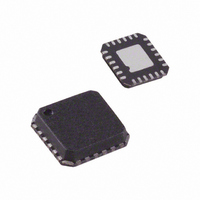ADL5385ACPZ-R7 Analog Devices Inc, ADL5385ACPZ-R7 Datasheet - Page 17

ADL5385ACPZ-R7
Manufacturer Part Number
ADL5385ACPZ-R7
Description
IC, QUAD MODULATOR 50MHZ-2.2GHZ LFCSP-24
Manufacturer
Analog Devices Inc
Datasheet
1.ADL5385ACPZ-R7.pdf
(24 pages)
Specifications of ADL5385ACPZ-R7
Frequency Range
50MHz To 2.2GHz
Rf Type
Quadrature
Supply Voltage Range
4.75V To 5.5V
Rf Ic Case Style
LFCSP
No. Of Pins
24
Operating Temperature Range
-40°C To +85°C
Design Resources
Broadband Low EVM Direct Conversion Transmitter Using LO Divide-by-2 Modulator (CN0144)
Function
Modulator
Lo Frequency
50MHz ~ 2.2GHz
Rf Frequency
50MHz ~ 2.2GHz
P1db
8dBm
Noise Floor
-160dBm/Hz
Output Power
2.6dBm
Current - Supply
240mA
Voltage - Supply
4.75 V ~ 5.25 V
Test Frequency
2.15GHz
Package / Case
24-VFQFN, 24-CSP Exposed Pad
Rohs Compliant
Yes
Lead Free Status / RoHS Status
Lead free / RoHS Compliant
Other names
ADL5385ACPZ-R7TR
SPECTRAL PRODUCTS FROM HARMONIC MIXING
For broadband applications such as cable TV head-end
modulators, special attention must be paid to harmonics of the
LO. Figure 39 shows the level of these harmonics (out to 3 GHz)
as a function of the output frequency from 50 MHz to 1000 MHz,
in a single-sideband (SSB) test configuration, with a baseband
signal of 1 MHz and a SSB level of approximately −5 dBm. To
read this plot correctly, first pick the output frequency of
interest on the trace called P
be read off the harmonic traces at multiples of this frequency.
For example, at an output frequency of 500 MHz, the
fundamental power is −5 dBm. The power of the second
(P
and −16 dBm (at 1500 MHz), respectively. Of particular
importance are the products from odd-harmonics of the LO,
generated from the switching operation in the mixers.
For cable TV operation at frequencies above approximately
500 MHz, these harmonics fall out of the band and can be
filtered by a fixed filter. However, as the frequency drops below
500 MHz, these harmonics start to fall close to or inside the
cable band. This calls for either limitation of the frequency
range to above 500 MHz or the use of a switchable filter bank to
block in-band harmonics at low frequencies.
Figure 38. ACP1, ACP2, ACP3, and Modulation Error Ratio (MER) vs. Output
2fc − BB
–50
–55
–60
–65
–70
–75
–80
–85
–90
) and third (P
–24
–22
ACPR2 (5.25MHz)
ACPR3 (6.00MHz)
Power for 256 QAM Transmitter
3fc + BB
–20
CARRIER POWER (dBm)
) harmonics is −63 dBm (at 1000 MHz)
–18
OUT
ACPR1 (750kHz)
. The associated harmonics can
MER
–16
–14
–12
–10
48
47
46
45
44
43
42
41
40
Rev. 0 | Page 17 of 24
RF SECOND-ORDER PRODUCTS
A two-tone RF output signal produces second-order spectral
components at sum and difference frequencies. In broadband
systems, these intermodulation products fall inside the carrier
or in the adjacent channels. Output second-order RF
intermodulation intercept is defined as
where P
F
as a function of carrier frequency in Figure 40, where the
baseband tones are 3.5 MHz and 4.5 MHz at −5 dBm each.
OUT1
Figure 40. Output Second-Order Intermodulation vs. Carrier Frequency
OIP2_RF = P
+ F
–10
–20
–30
–40
–50
–60
–70
–80
–90
70
60
50
40
30
20
10
IM(RF)
0
Figure 39. Spectral Components for Output Frequencies
0
OUT2
0
0
. OIP2_RF levels from a two-tone test are plotted
is the level of the intermodulation product at
100
250
P
7LO + BB
OUT
200
500
from 50 MHz to 1000 MHz
+ (P
300
OUTPUT FREQUENCY (MHz)
OUTPUT FREQUENCY (MHz)
750
OUT
400
P
6LO – BB
− P
1000
500
IM(RF)
1250
P
5LO – BB
)
600
1500
P
700
4LO + BB
P
3LO + BB
1750
P
800
OUT
P
2LO – BB
ADL5385
2000
900
1000
2250












